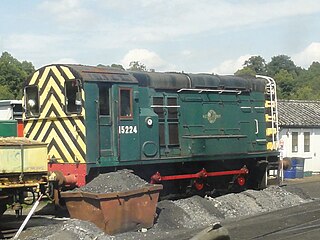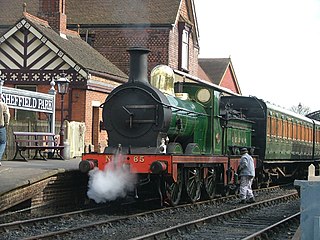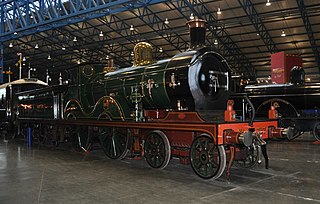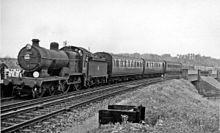
The British Rail Class 12 is a diesel locomotive built primarily for shunting duties around London.
John George Robinson CBE, was an English railway engineer, and was chief mechanical engineer of the Great Central Railway from 1900 to 1922.
The Southern Railway took a key role in expanding the 660 V DC third rail electrified network begun by the London & South Western Railway. As a result of this, and its smaller operating area, its steam locomotive stock was the smallest of the 'Big Four' companies.

The SR Class W were 3-cylinder 2-6-4T tank engines designed in 1929 by Richard Maunsell for use on the Southern Railway. They were introduced in 1932 and constructed at Eastleigh and Ashford. The class was intended for short distance, inter-company/regional freight traffic transfer in London, and were standardised with parts from the N, N1, U and U1 classes.

Brighton railway works was one of the earliest railway-owned locomotive repair works, founded in 1840 by the London and Brighton Railway in Brighton, England, and thus pre-dating the more famous railway works at Crewe, Doncaster and Swindon. The works grew steadily between 1841 and 1900 but efficient operation was always hampered by the restricted site, and there were several plans to close it and move the facility elsewhere. Nevertheless, between 1852 and 1957 more than 1200 steam locomotives as well as prototype diesel electric and electric locomotives were constructed there, before the eventual closure of the facility in 1962.

The South Eastern and Chatham Railway (SECR) C Class is a class of 0-6-0 steam locomotive, designed by Harry Wainwright and built between 1900 and 1908. They were designed for freight duties, although occasionally used for passenger trains. They operated over the lines of the railway in London and south-east England until the early 1960s. One example was rebuilt as an S Class saddle tank.

British Rail class D3/12 was a class of three experimental diesel-electric shunting locomotives designed by Richard Maunsell of the Southern Railway in 1937. They quickly proved their effectiveness, but the Second World War prevented more of them being built. Oliver Bulleid based the British Rail Class 12 on them in 1949.
Harry Smith Wainwright was an English railway engineer, and was the Locomotive, Carriage and Wagon Superintendent of the South Eastern and Chatham Railway from 1899 to 1913. He is best known for a series of simple but competent locomotives produced under his direction at the company's Ashford railway works in the early years of the twentieth century. Many of these survived in service until the end of steam traction in Britain in 1968, and are regarded as some of the most elegant designs of the period.

The South Eastern Railway (SER) O Class was a class of 0-6-0 steam locomotive designed for goods work, and were the main goods engines of the SER, and later the South Eastern and Chatham Railway (SECR) for a number of years. However, they were displaced by the more powerful C class locomotives following the amalgamation of the South Eastern Railway and London, Chatham and Dover Railway (LCDR) in 1899. This relegated the class to working on the numerous branch lines in Kent, on both passenger and goods work. They worked most notably on the Kent & East Sussex Railway and East Kent Railway, operating coal trains from the Kent coal fields to London, as well as shunting work at such locations as Shepherds Well, Hoo Junction and Ashford. The majority were withdrawn before the outbreak of the Second World War in 1939, and those that remained were slowly withdrawn from nationalisation onwards.

The SECR N class was a type of 2-6-0 ("mogul") steam locomotive designed in 1914 by Richard Maunsell for mixed-traffic duties on the South Eastern and Chatham Railway (SECR). Built between 1917 and 1934, it was the first non-Great Western Railway (GWR) type to use and improve upon the basic design principles established by GWR Chief Mechanical Engineer (CME) George Jackson Churchward. The N class was based on the GWR 4300 Class design, improved with Midland Railway concepts.

Stratford Works was the locomotive-building works of the Great Eastern Railway situated at Stratford, London, England. The original site of the works was located in the 'V' between the Great Eastern Main Line and the Stratford to Lea Bridge route and in the early years was also the home of Stratford Locomotive Depot. The final part of the works closed in 1991.

The SECR D class is a class of 4-4-0 tender locomotives designed by Harry Wainwright for the South Eastern and Chatham Railway.

The SECR B1 class was a class of 4-4-0 steam tender locomotive for express passenger service on the South Eastern and Chatham Railway. These engines were originally designed by James Stirling for the South Eastern Railway (SER) in 1898 and designated B class. The SER was merged into the SECR in 1899 and, between 1910 and 1927 the B class engines were rebuilt with new boilers by Harry Wainwright to become B1 class.

James Stirling (1835–1917) was a Scottish mechanical engineer. He was Locomotive Superintendent of the Glasgow and South Western Railway and later the South Eastern Railway. Stirling was born on 2 October 1835, a son of Robert Stirling, rector of Galston, East Ayrshire.
James I'Anson Cudworth was an English railway engineer, and was Locomotive Superintendent of the South Eastern Railway (SER). He served in this capacity from 1845 to 1876. He is notable for designing a successful method for burning coal in steam locomotives without significant emission of smoke, and for introducing the 0-4-4T wheel arrangement to English railways.

The LCDR R1 class was a class of 0-4-4T locomotives on the South Eastern and Chatham Railway (SECR), which were based on an existing London, Chatham and Dover Railway (LCDR) design.

The SECR J class was a class of 0-6-4T steam tank locomotive built for heavy freight service on the South Eastern and Chatham Railway, by Harry Wainwright.
The SECR Q1 class was a class of 0-4-4T steam locomotives of the South Eastern and Chatham Railway. The class was rebuilt from older Stirling Q class locomotives by Harry Wainwright between 1903 and 1917 by fitting the boiler that had been designed for the H class 0-4-4T in 1902–03.

The SER Q class was a class of 0-4-4T steam locomotives of the South Eastern Railway. The class was designed by James Stirling and introduced in 1881.

The SER A class was a class of 4-4-0 locomotives on the South Eastern Railway.


















